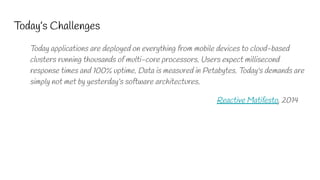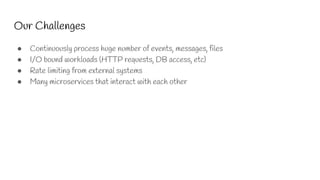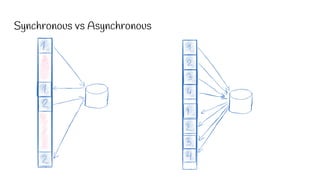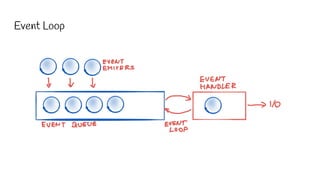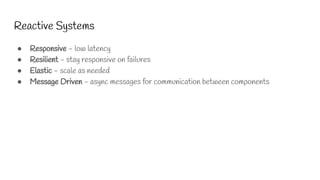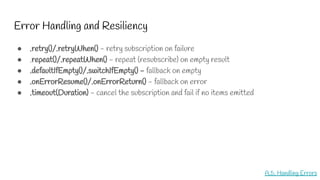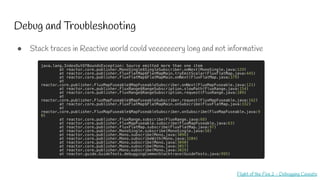Reactive Applications in Java
- 1. Reactive Applications in Java Alex Mrynskyi Palo Alto Networks
- 2. Our Team
- 3. Agenda ● The Problem ● What is Reactive Applications? ● Project Reactor 101 ● How to Start with Reactive?
- 5. Today’s Challenges Today applications are deployed on everything from mobile devices to cloud-based clusters running thousands of multi-core processors. Users expect millisecond response times and 100% uptime. Data is measured in Petabytes. Today's demands are simply not met by yesterday’s software architectures. Reactive Matifesto, 2014
- 6. The Rise of Microservices
- 7. The Rise of Microservices
- 8. Our Challenges ● Continuously process huge number of events, messages, files ● I/O bound workloads (HTTP requests, DB access, etc) ● Rate limiting from external systems ● Many microservices that interact with each other
- 10. Event Loop
- 11. Little's Law Little's law, Wikipedia long-term average number L of customers in a stationary system is equal to the long-term average effective arrival rate λ multiplied by the average time W that a customer spends in the system
- 12. Little's Law in Practice Stop Rate Limiting! Capacity Management Done Right" by Jon Moore, Youtube The number of active workers must be at least the average arrival rate of tasks multiplied by the average time to process those tasks workers >= tasks per second x time to process task or workers >= throughput x latency or throughput <= workers / latency
- 13. Web MVC with Blocking I/O
- 14. WebFlux with Non-Blocking I/O
- 15. Web MVC with Blocking I/O (multiple threads)
- 16. Web MVC vs WebFlux Source - Hands-On Reactive Programming in Spring 5 Conclusion - WebFlux is much more efficient with regard to throughput, latency, and CPU usage.
- 17. Reactive Applications Photo by Brayden Law from Pexels
- 18. Reactive Glossary “Reactive” has become an overloaded term and is now being associated with several different things to different people ● Reactive programming is a paradigm in which declarative code is issued to construct asynchronous processing pipelines ● Reactive streams is an initiative that was created to provide a standard to unify reactive extensions and deal with asynchronous stream processing with non-blocking backpressure ● Reactive systems—as defined by the Reactive Manifesto—is a set of architectural design principles for building modern systems that are well prepared to meet the increasing demands that applications face today ● Reactive programming and Reactive streams are all useful tools to design and build Reactive systems Reactive programming vs. Reactive systems
- 20. Reactive Systems ● Responsive - low latency ● Resilient - stay responsive on failures ● Elastic - scale as needed ● Message Driven - async messages for communication between components
- 21. Reactive Streams Photo by Avery Nielsen-Webb from Pexels
- 22. Reactive Streams API public interface Processor<T, R> extends Subscriber<T>, Publisher<R> {} public interface Publisher<T> { public void subscribe(Subscriber<? super T> s); } public interface Subscriber<T> { public void onSubscribe(Subscription s); public void onNext(T t); public void onError(Throwable t); public void onComplete(); } public interface Subscription { public void request(long n); public void cancel(); } Don’t try it at home!!!
- 23. Reactive Signals Photo by Avery Nielsen-Webb from Pexels
- 24. Reactive Streams Implementations ● RxJava (Netflix) ● Reactor (Pivotal) ● Vert.x (RedHat) ● Akka Streams (Typesafe)
- 25. Project Reactor Photo by Avery Nielsen-Webb from Pexels
- 26. Project Reactor Photo by Avery Nielsen-Webb from Pexels ● Reactor is a fourth-generation reactive library, based on the Reactive Streams specification, for building non-blocking applications on the JVM ● Fully non-blocking and backpressure-ready network runtimes, including local TCP/HTTP/UDP clients and servers, based on the robust Netty framework ● Foundation of the reactive stack in the Spring ecosystem and is featured in projects such as Spring WebFlux, Spring Data, and Spring Cloud Gateway
- 27. Reactive Stack in Spring Boot
- 28. Web on Reactive Stack ● WebFlux is a non-blocking web stack to handle concurrency with a small number of threads and scale with fewer hardware resources ● Uses Reactor Netty by default ● Supports two programming models ○ Annotated Controllers: Consistent with Spring MVC and based on the same annotations from the spring-web module ○ Functional Endpoints: Lambda-based, lightweight, and functional programming model
- 29. Reactive Libraries and Clients ● MongoDB, Redis, and Cassandra all have native reactive support in Spring Data ● Many relational databases (Postgres, Microsoft SQL Server, MySQL, H2, and Google Spanner) have reactive support via R2DBC ● Reactor Kafka and Reactor RabbitMQ for messaging ● AWS SDK v2 is fully asynchronous and could be easily wrapped ● WebClient with functional, fluent API based on Reactor ● Resilience4j for Circuit Breaker, Rate Limiter, Retry or Bulkhead in a reactive way
- 30. Project Reactor 101 Photo by Avery Nielsen-Webb from Pexels Photo by Ekaterina Belinskaya from Pexels
- 31. Flux An Asynchronous Sequence of 0-N Items
- 32. Mono An Asynchronous 0-1 Result
- 33. Marble Diagrams Photo by Avery Nielsen-Webb from Pexels Appendix B: How to read marble diagrams?
- 34. Operators ● .map, .filter, .flatMap, .take, .buffer, .subscribe, .... ● Not a part of Reactive Streams specification Appendix A: Which operator do I need?
- 35. Assembly vs Subscription Photo by Avery Nielsen-Webb from Pexels Nothing Happens Until You Subscribe Flight of the Flux 1 - Assembly vs Subscription ● Calling methods on a Flux or Mono (the operators) doesn’t immediately trigger the behavior. This declarative phase is called assembly time. ● To trigger data to flow we you need to subscribe to the declared pipeline
- 36. Demo Time Photo by Avery Nielsen-Webb from Pexels Photo by PRAPHAPHAN WONGSAWAN from Pexels
- 37. flatMap Photo by Avery Nielsen-Webb from Pexels
- 38. “flatMap Pack” Photo by Avery Nielsen-Webb from Pexels ● .flatMap()/.flatMapMany() - transforms the elements asynchronously into Publishers, then flatten these inner publishers into a single Flux through merging ● .concatMap() - transforms the elements asynchronously into Publishers, then flatten these inner publishers into a single Flux, sequentially and preserving order using concatenation ● .flatMapSequential() - transforms the elements asynchronously into Publishers, then flatten these inner publishers into a single Flux, but merge them in the order of their source element
- 39. Threading Model Photo by Avery Nielsen-Webb from Pexels ● considered to be concurrency-agnostic ● Schedulers.parallel() ○ non-blocking operations ○ fixed size ○ number of of threads = number CPU cores ● Schedulers.boundedElastic() ○ usually used to offload blocking operations ○ creates new worker pools as needed and reuses idle ones ○ number of of threads = number of CPU cores x 10 ● Schedulers.single() ○ a single, reusable thread Flight of the Flux 3 - Hopping Threads and Schedulers
- 40. Wrapping Blocking Code Photo by Avery Nielsen-Webb from Pexels ● Reactor offers two means of switching the execution context (or Scheduler) in a reactive chain: publishOn and subscribeOn
- 41. Error Handling and Resiliency Photo by Avery Nielsen-Webb from Pexels ● .retry()/.retryWhen() - retry subscription on failure ● .repeat()/.repeatWhen() - repeat (resubscribe) on empty result ● .defaultIfEmpty()/.switchIfEmpty() - fallback on empty ● .onErrorResume()/.onErrorReturn() - fallback on error ● .timeout(Duration) - cancel the subscription and fail if no items emitted A.5. Handling Errors
- 42. Testing Photo by Avery Nielsen-Webb from Pexels
- 43. Debug and Troubleshooting Photo by Avery Nielsen-Webb from Pexels Flight of the Flux 2 - Debugging Caveats ● Stack traces in Reactive world could veeeeeeery long and not informative
- 44. Debug and Troubleshooting Photo by Avery Nielsen-Webb from Pexels Flight of the Flux 2 - Debugging Caveats ● Integrate ReactorDebugAgent - a Java agent which helps debugging exceptions in your application without paying a runtime cost (unlike Hooks.onOperatorDebug()) ○ Hooks.onOperatorDebug() is still really useful in tests ● Use .log() and .checkpoint() operators in development to understand the flow ● Integrate BlockHound into tests to detect blocking code (tests only !!!)
- 45. Reactive “Laws” Photo by Avery Nielsen-Webb from Pexels ● NOTHING happens until you subscribe ○ Idialy subscribe only once ● NEVER block parallel scheduler ○ Run blocking code on a separate Scheduler (i.e. boundedElastic) ● STOP thinking in threads ○ Think about concurrency instead
- 46. Learning Resources - Intro Photo by Avery Nielsen-Webb from Pexels ● Video Flight of the Flux: A Look at Reactor Execution Model ● Blog series Flight of the Flux 1 - Assembly vs Subscription ● Video Avoiding Reactor Meltdown ● Video Do’s and Don’ts: Avoiding First-Time Reactive Programmer Mines - must ● The introduction to Reactive Programming you've been missing - not java but very good explanation of the idea behind reactive programming
- 47. Learning Resources - Hands-on Photo by Avery Nielsen-Webb from Pexels ● Introduction to Reactive Programming or the same on github GitHub - reactor/lite-rx-api-hands-on: Lite Rx API Hands-On with Reactor Core 3. Just get repo and fix all unit tests ● Head-First Reactive Workshop GitHub - reactor/head-first-reactive-with-spring-and-reactor
- 48. Learning Resources - Hardcore Photo by Avery Nielsen-Webb from Pexels 3-video series about Reactor internals ● https:/ /www.youtube.com/watch?v=OdSZ6mOQDcY ● https:/ /www.youtube.com/watch?v=noeWdjO4fyU ● https:/ /www.youtube.com/watch?v=cVKhFPiebSs





